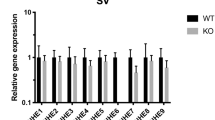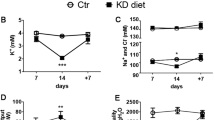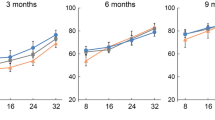Abstract
Hearing depends on a high K+ concentration bathing the apical membranes of sensory hair cells. K+ that has entered hair cells through apical mechanosensitive channels is transported to the stria vascularis for re-secretion into the scala media1. K+ probably exits outer hair cells by KCNQ4 K+ channels2,3, and is then transported—by means of a gap junction system connecting supporting Deiters' cells and fibrocytes4—back to the stria vascularis. We show here that mice lacking the K+/Cl- (K-Cl) co-transporter Kcc4 (coded for by Slc12a7) are deaf because their hair cells degenerate rapidly after the beginning of hearing. In the mature organ of Corti, Kcc4 is restricted to supporting cells of outer and inner hair cells. Our data suggest that Kcc4 is important for K+ recycling1,5 by siphoning K+ ions after their exit from outer hair cells into supporting Deiters’ cells, where K+ enters the gap junction pathway. Similar to some human genetic syndromes6, deafness in Kcc4-deficient mice is associated with renal tubular acidosis. It probably results from an impairment of Cl- recycling across the basolateral membrane of acid-secreting α-intercalated cells of the distal nephron.
This is a preview of subscription content, access via your institution
Access options
Subscribe to this journal
Receive 51 print issues and online access
$199.00 per year
only $3.90 per issue
Buy this article
- Purchase on Springer Link
- Instant access to full article PDF
Prices may be subject to local taxes which are calculated during checkout




Similar content being viewed by others
References
Steel, K. P. & Kros, C. J. A genetic approach to understanding auditory function. Nature Genet. 27, 143–149 (2001).
Kubisch, C. et al. KCNQ4, a novel potassium channel expressed in sensory outer hair cells, is mutated in dominant deafness. Cell 96, 437–446 (1999).
Kharkovets, T. et al. KCNQ4, a K+ channel mutated in a form of dominant deafness, is expressed in the inner ear and the central auditory pathway. Proc. Natl Acad. Sci. USA 97, 4333–4338 (2000).
Kikuchi, T., Kimura, R. S., Paul, D. L., Takasaka, T. & Adams, J. C. Gap junction systems in the mammalian cochlea. Brain Res. Brain Res. Rev. 32, 163–166 (2000).
Jentsch, T. J. Neuronal KCNQ potassium channels: physiology and role in disease. Nature Rev. Neurosci. 1, 21–30 (2000).
Karet, F. E. et al. Mutations in the gene encoding B1 subunit of H+-ATPase cause renal tubular acidosis with sensorineural deafness. Nature Genet. 21, 84–90 (1999).
Lauf, P. K. & Adragna, N. C. K-Cl cotransport: properties and molecular mechanism. Cell Physiol. Biochem. 10, 341–354 (2000).
Hübner, C. A. et al. Disruption of KCC2 reveals an essential role of K-Cl cotransport already in early synaptic inhibition. Neuron 30, 515–524 (2001).
Payne, J. A. Functional characterization of the neuronal-specific K-Cl cotransporter: implications for [K+]o regulation. Am. J. Physiol. 273, C1516–C1525 (1997).
Mount, D. B. et al. Cloning and characterization of KCC3 and KCC4, new members of the cation-chloride cotransporter gene family. J. Biol. Chem. 274, 16355–16362 (1999).
Vetter, D. E. et al. Inner ear defects induced by null mutation of the isk gene. Neuron 17, 1251–1264 (1996).
Delpire, E., Lu, J., England, R., Dull, C. & Thorne, T. Deafness and imbalance associated with inactivation of the secretory Na-K-2Cl co-transporter. Nature Genet. 22, 192–195 (1999).
Dixon, M. J. et al. Mutation of the Na-K-Cl co-transporter gene Slc12a2 results in deafness in mice. Hum. Mol. Genet. 8, 1579–1584 (1999).
Lee, M. P. et al. Targeted disruption of the Kvlqt1 gene causes deafness and gastric hyperplasia in mice. J. Clin. Invest. 106, 1447–1455 (2000).
Kikuchi, T., Kimura, R. S., Paul, D. L. & Adams, J. C. Gap junctions in the rat cochlea: immunohistochemical and ultrastructural analysis. Anat. Embryol. (Berl.) 191, 101–118 (1995).
Spicer, S. S. & Schulte, B. A. Evidence for a medial K+ recycling pathway from inner hair cells. Hear Res. 118, 1–12 (1998).
Wada, J., Kambayashi, J., Marcus, D. C. & Thalmann, R. Vascular perfusion of the cochlea: effect of potassium-free and rubidium-substituted media. Arch. Otorhinolaryngol. 225, 79–81 (1979).
Weber, P. C., Cunningham, C. D. III & Schulte, B. A. Potassium recycling pathways in the human cochlea. Laryngoscope 111, 1156–1165 (2001).
Spicer, S. S. & Schulte, B. A. Creatine kinase in epithelium of the inner ear. J. Histochem. Cytochem. 40, 185–192 (1992).
Nenov, A. P., Chen, C. & Bobbin, R. P. Outward rectifying potassium currents are the dominant voltage activated currents present in Deiter's cells. Hear. Res. 123, 168–182 (1998).
Johnstone, B. M., Patuzzi, R., Syka, J. & Sykova, E. Stimulus-related potassium changes in the organ of Corti of guinea-pig. J. Physiol. 408, 77–92 (1989).
Kelsell, D. P. et al. Connexin 26 mutations in hereditary non-syndromic sensorineural deafness. Nature 387, 80–83 (1997).
Oliver, D. et al. Intracellular anions as the voltage sensor of prestin, the outer hair cell motor protein. Science 292, 2340–2343 (2001).
Rodríguez-Soriano, J. New insights into the pathogenesis of renal tubular acidosis—from functional to molecular studies. Pediatr. Nephrol. 14, 1121–1136 (2000).
Beck, F. X., Dörge, A., Giebisch, G. & Thurau, K. Renal excretion of rubidium and potassium: an electron microprobe and clearance study. Kidney Int. 34, 455–462 (1988).
Bruce, L. J. et al. Familial distal renal tubular acidosis is associated with mutations in the red cell anion exchanger (Band 3, AE1) gene. J. Clin. Invest. 100, 1693–1707 (1997).
Voss, A. K., Thomas, T. & Gruss, P. Germ line chimeras from female ES cells. Exp. Cell Res. 230, 45–49 (1997).
Nielsen, S., DiGiovanni, S. R., Christensen, E. I., Knepper, M. A. & Harris, H. W. Cellular and subcellular immunolocalization of vasopressin-regulated water channel in rat kidney. Proc. Natl Acad. Sci. USA 90, 11663–11667 (1993).
Estévez, R. et al. Barttin is a Cl- channel β-subunit crucial for renal Cl- reabsorption and inner ear K+ secretion. Nature 414, 558–561 (2000).
Beck, F. X., Schmolke, M., Guder, W. G., Dörge, A. & Thurau, K. Osmolytes in renal medulla during rapid changes in papillary tonicity. Am. J. Physiol. 262, F849–F856 (1992).
Acknowledgements
We thank J. Faulhaber and H. Ehmke for blood gas analysis; M. Bösl for blastocyst injection and implantation; M. Knipper for the prestin antiserum; M. Knepper for the aquaporin 2 antiserum; S. Gluck for the proton ATPase antiserum; M. Kolster, B. Dierkes and I. Öztürk for technical assistance; H. Voss for taking care of animals; and U. Koch for support. This work was supported by grants from the Deutsche Forschungsgemeinschaft, the Fonds der Chemischen Industrie, and the Prix Louis-Jeantet de Médecine to T.J.J.
Author information
Authors and Affiliations
Corresponding author
Ethics declarations
Competing interests
The authors declare that they have no competing financial interests
Supplementary information
Rights and permissions
About this article
Cite this article
Boettger, T., Hübner, C., Maier, H. et al. Deafness and renal tubular acidosis in mice lacking the K-Cl co-transporter Kcc4. Nature 416, 874–878 (2002). https://doi.org/10.1038/416874a
Received:
Accepted:
Issue Date:
DOI: https://doi.org/10.1038/416874a
This article is cited by
-
The pathophysiology of distal renal tubular acidosis
Nature Reviews Nephrology (2023)
-
Age-related hearing loss pertaining to potassium ion channels in the cochlea and auditory pathway
Pflügers Archiv - European Journal of Physiology (2021)
-
Screening and function discussion of a hereditary renal tubular acidosis family pathogenic gene
Cell Death & Disease (2020)
-
Distal renal tubular acidosis: genetic causes and management
World Journal of Pediatrics (2019)
Comments
By submitting a comment you agree to abide by our Terms and Community Guidelines. If you find something abusive or that does not comply with our terms or guidelines please flag it as inappropriate.



